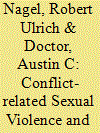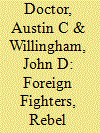| Srl | Item |
| 1 |
ID:
173130


|
|
|
|
|
| Summary/Abstract |
To what extent does sexual violence influence rebel group fragmentation? A substantial body of research explores wartime rape as a cohesion-building mechanism following forced recruitment. However, the relationship between sexual violence and broader organizational structural integrity has not been systematically tested. Our study on the effects of sexual violence on rebel group fragmentation provides this test. We argue that sexual violence increases cohesion at the battalion level but increases the risk of fragmentation of the broader organization because lieutenants are more likely to split from organizations if they are confident that their subordinate battalions are cohesive and will follow them. We test this argument on a global sample of 105 rebel organizations active between 1989 and 2014. The results provide robust support for the argument showing sexual violence increases the probability of fragmentation by a factor of six. This presents a crucial contribution to our understanding of sexual violence and rebel group fragmentation.
|
|
|
|
|
|
|
|
|
|
|
|
|
|
|
|
| 2 |
ID:
188070


|
|
|
|
|
| Summary/Abstract |
Recent studies find that the presence of foreign fighters in a rebel organization may increase levels of anti-civilian violence in civil war. But why? Evidence from some cases indicates that foreign fighters may be used intentionally by local rebel commanders to carry out abusive operations against noncombatants. Other cases, however, suggest that foreign fighters possess greater capacity for independent agency in war, stepping outside the chain of command to inflict harm against local noncombatants. We argue that variation in a rebel group’s command structure—specifically, their degree of centralization—offers a point of leverage with which to adjudicate between the generalizability of these competing explanations. We investigate this issue with an analysis of sixty-nine rebel groups active between 1989 and 2015. We find that the effect of foreign fighters on civilian targeting is conditional: foreign fighters are associated with greater levels of anti-civilian violence only when active in groups with centralized command structures. This study contributes to the nascent literature on foreign fighters, offering insight into how these actors step into the command structures of rebel organizations. This study also demonstrates that the abuse of civilians in conflict can be explained effectively based on the characteristics of armed parties.
|
|
|
|
|
|
|
|
|
|
|
|
|
|
|
|
| 3 |
ID:
182560


|
|
|
|
|
| Summary/Abstract |
Rebels groups adopt different organisational structures, emerging in various shapes and sizes. Some rebel groups construct distinct military and political wings, delegating their military and political operations to specialised units. While recent studies have made great strides towards understanding militant groups’ activities on and off the battlefield, the literature has been less attentive to the root causes of the structural arrangements which groups form for these purposes. I argue that rebel leaders’ pre-war military and political experiences shape the structure of the organisations they lead into war. Using original data, I find that differences in leaders’ pre-war military experience, rather than political experience, are associated with discernible probabilities of rebel operational specialisation. In addition to offering practitioners and academics a comparative framework with which to evaluate the patterns of militant leadership, this study demonstrates how leaders wield independent agency over group structure and operations in the civil war environment.
|
|
|
|
|
|
|
|
|
|
|
|
|
|
|
|